Fort Oranje (Sint Eustatius)
Fort Oranje is a historic fortress located in Sint Eustatius in the Dutch Caribbean. It is located in Oranjestad, the island's capital, on a cliff overlooking Oranje Bay.[1] It was named after the House of Oranje, the royal family of the Netherlands.[2]
| Fort Oranje | |
|---|---|
| Oranjestad, Sint Eustatius | |
 View of Fort Oranje | |
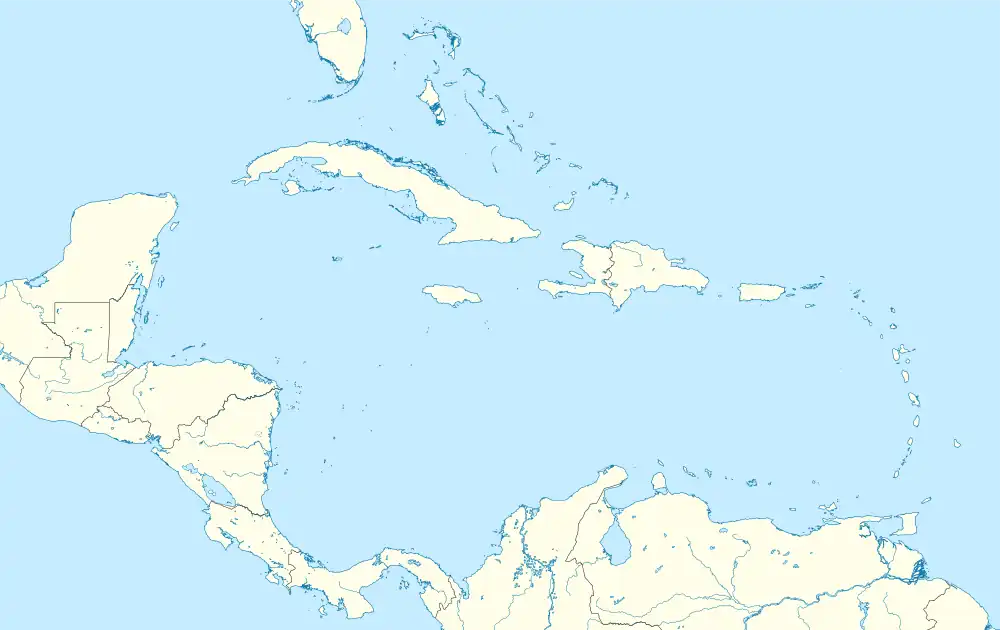 Fort Oranje | |
| Coordinates | 17.4820°N 62.9865°W |
| Type | Fortification |
| Site information | |
| Open to the public | Yes |
| Site history | |
| Built | 1636 |
| In use | No |
The fort was built by the Dutch in 1636, at the location of a previous fort built by the French in 1629.[3][4] Its construction was commissioned by the Dutch West India Company.[5][6] Like the island, the fort changed hands several times between the Dutch, English and French.[7] It was rebuilt and renovated several times during the 17th and 18th centuries.[3][4] Today, the fort is one of many protected buildings in Sint Eustatius.
History
The first European settlers on St. Eustatius were the French, who arrived from 1625 and 1629.[8] They came from nearby nearby St. Kitts. In 1629, the French built a wooden fortress at the present-day location of Fort Oranje.[3][4] The French abandoned the fort and the island due to lack of clean drinking water.[9][10]
In 1636, Dutch settlers from Zeeland took possession of the then unoccupied St. Eustatius.[11][12] With a commission from the Dutch West India Company, they constructed a new fort at the location where they found remains of the French fort.[5][6] They named the new fortress Fort Oranje after the House of Oranje, the Dutch royal family.[2]
The original Fort Oranje for square-shaped, with four bastions, a courtyard, and 16 mounted cannons.[3] Historians presume it was wooden, as it was burned by the Dutch in 1673 and rebuilt by the English later in the year.[4][3] In 1689, the French took over the island and fort, and carried out additional renovations of the fort.[3][4] They reinforced the walls with doubled palisades and built a dry moat around the fort.[13] Beginning in 1737, the fort underwent a series of renovations by the Dutch via the work of enslaved Africans.[3][4]
Until 1846, Fort Oranje served as a garrison for army infantry and artillery. After being empty for many years, the fortress was refurbished and furnished as an administrative center to house the lieutenant governor's office, government services, and the prison.
After partial fire destruction in 1990,[14][15] the fort was restored in the late 1990s.[16] Since then, the offices of the public prosecutor's office, the planning department, and the tourist office have been kept here.[17]
The "First Salute"
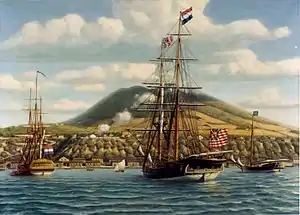
It was from Fort Oranje that the famous First Salute was fired on November 16, 1776. Dutch governor Johannes de Graaff had the fort's cannons return a salute of 11 shots to the USS Andrew Doria,[18] which had entered the island's harbor. The ship was flying the new Grand Union Flag,[19] as the American thirteen colonies had just declared their independence from the British. Many interpreted the salute as the first recognition by a foreign power of America's independence.[20] It was one of the reasons for the Fourth Anglo-Dutch War (1780-1784).[21][22]
In 1939, President Franklin Delano Roosevelt offered a plaque in recognition of the First Salute.[3][23] The plaque was placed against the flagpole in the fort square.[23]
Preservation
Between February 2019 to May 2020, the cliff supporting Fort Oranje underwent a stabilization project to help increase the cliff's stability and stop erosion.[24] The project involved the placement of 2,800 anchors, 7,400 square meters of canvas, and more than 15,000 square meters of mesh.[24]
Gallery
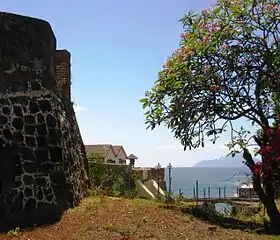 The walls of Fort Oranje with the island of Saba in the background
The walls of Fort Oranje with the island of Saba in the background.jpg.webp) Inside the walls of Fort Oranje
Inside the walls of Fort Oranje View of the island from Fort Oranje
View of the island from Fort Oranje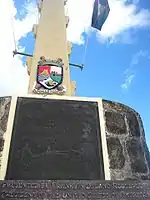 Plaque presented by Franklin D. Roosevelt in recognition of the "First Salute"
Plaque presented by Franklin D. Roosevelt in recognition of the "First Salute"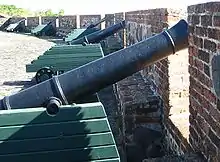 Canons at Fort Oranje
Canons at Fort Oranje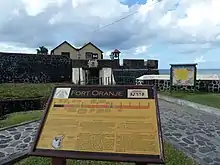 Fort Oranje timeline, located at the fort
Fort Oranje timeline, located at the fort
References
- Gilmore, R. G. (2013), Comer, Douglas C. (ed.), "St. Eustatius: The Nexus for Colonial Caribbean Capitalism", The Archaeology of Interdependence: European Involvement in the Development of a Sovereign United States, SpringerBriefs in Archaeology, New York, NY: Springer, vol. 1, pp. 41–60, doi:10.1007/978-1-4614-6028-2_3, ISBN 978-1-4614-6028-2, retrieved 2023-04-01
- "Fort Oranje". Statia Tourism. St. Eustatius Tourism Development Foundation. Retrieved 2023-04-01.
- Hartog, Johannes (1976). History of St. Eustatius. Central U.S.A. Bicentennial Committee of the Netherlands Antilles : distributors, De Witt Stores N.V.
- St. Eustatius Fort Oranje: A Historical Archaeological and Architectural Assessment (PDF) (Report). St. Eustatius Center for Archaeological Research. 2011-07-12. Archived from the original (PDF) on 2023-01-13.
- Henderson, James (1992). The Caribbean. Cadogan Books. p. 330. ISBN 978-1-56440-003-1.
- Comer, Douglas C. (2013-01-04). The Archaeology of Interdependence: European Involvement in the Development of a Sovereign United States. Springer Science & Business Media. p. 42. ISBN 978-1-4614-6028-2.
- "History: About St. Eustatius". Statia Government. 2020-06-16. Retrieved 2023-04-02.
- Benjamins, Herman Daniël; Snelleman, Johannes (1917). Encyclopaedie van Nederlandsch West-Indië. Digital Library for Dutch Literature (in Dutch). Leiden: Martinus Nijhoff Publishers.
- Stelten, R.J.G. (2019). "From Golden Rock to Historic Gem: a historical archaeological analysis of the maritime cultural landscape of St. Eustatius, Dutch Caribbean (Doctoral Thesis)". Leiden University Scholarly Publications.
- Agency, Netherlands Ministry of Education, Culture and Science Cultural Heritage; UNESCO (2021-03-10). The UNESCO Training Manual for the Protection of the Underwater Cultural Heritage in Latin America and the Caribbean. UNESCO Publishing. p. 12. ISBN 978-92-3-100427-8.
{{cite book}}: CS1 maint: multiple names: authors list (link) - The Caribbean: Volumes 1-3. The Caribbean Commission. 1947.
{{cite book}}: CS1 maint: date and year (link) - Klooster, Wim (2016-10-19). The Dutch Moment: War, Trade, and Settlement in the Seventeenth-Century Atlantic World. Cornell University Press. ISBN 978-1-5017-0667-7.
- Hartog, Johan. De forten, verdedigingswerken en geschutstellingen van Sint Eustatius en Saba: van Pieter van Corselles tot Abraham Heyliger, 1636-1785. Europese bibliotheek, 1997. Print.
- Ruigrok, Paul (18 May 2020). "Government commissioner sees a long road ahead for self-governance on Statia". Caribbean Network.
- "Vlammen verwoest deel Fort Oranje" [Flames destroyed part of Fort Oranje]. Amigoe (in Dutch). 8 October 1990.
- van Ditzhuijzen, Jeannette (30 June 1998). "Rebels fort op Statia wordt hersteld" [Rebel fortress on Statia being restored]. Trouw (in Dutch).
- "History Fort Oranje". Public Prosecutor Curacao Sint Maarten BES Islands. 2021-01-15. Retrieved 2023-05-27.
- "U.S. Relations With the Netherlands". www.state.gov. Bureau of European and Eurasian Affairs, United States Department of State. 6 September 2022.
- "About St. Eustatius: First Salute". Statia Government. 2020-06-16. Retrieved 2023-04-02.
- Bartle, Annette (1975-12-07). "Statia's Heritage: Gifts From the Sea". The New York Times. ISSN 0362-4331. Retrieved 2023-04-01.
- Müller, Leos (2019). Neutrality in World History. New York: Taylor & Francis. ISBN 978-1-351-68305-0.
- Hellebrand, Walter (2018-10-22). "The First Salute: A unique moment in history". The Daily Herald. Retrieved 2023-05-27.
- "King and US President are welcome for 'First Salute'". The Daily Herald. 15 October 2018. Retrieved 27 May 2023.
- "Cliff stabilisation project for Fort Oranje nears completion". The Daily Herald. 2020-05-05. Archived from the original on 2023-04-01.